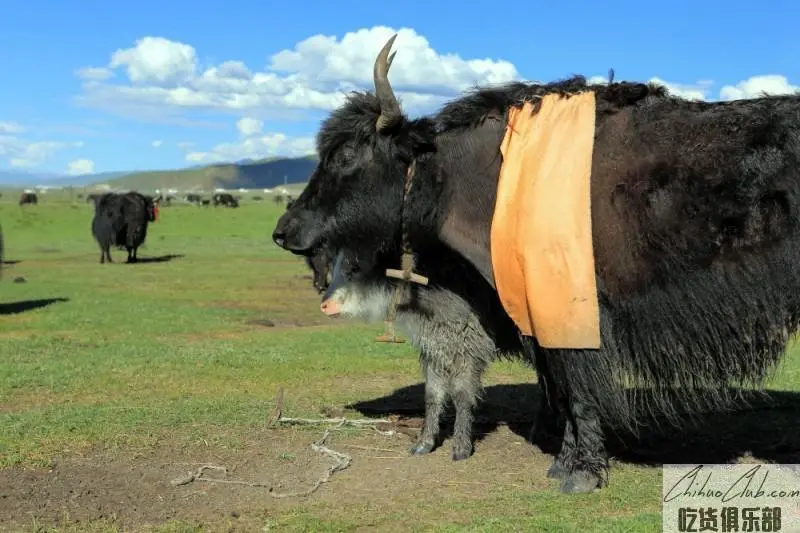
Dangxiong yak
-
Update date::
-
Date of protection::
-
Protected range:The origin of the male yak is the Dangquka Town, Yangbajing Town, Geda Township, Ningzhong Township, Gongtang Township, Longren Township, Wumatang Township and Namuhu Township of Dangxiong County, Lhasa City, Tibet Autonomous Region.
-
Category:
When male yaks grow in an unpolluted alpine zone at an altitude of 4,200 meters, the growth conditions are in full compliance with the requirements of green food. The yak meat is extremely rich in nutrients, containing 24.69% protein and 1.33% minerals. Its red blood cells and hemoglobin are 50-100% higher than yellow cattle. Its nutritional value is higher than that of yellow cattle, and only blood red protein is 50% higher than ordinary yellow cattle.
Dangxiong is located in the northern Tibetan grassland of Lhasa. The Tibetan language means “selected grassland”. The yak beef grown here is widely favored in all parts of Tibet. Dangxiong County is located at the junction of southern Tibet and northern Tibet, 170 kilometers away from Lhasa, with an average elevation of over 4,200 meters. As a pure animal husbandry county in Lhasa, Dangxiong County is mainly for raising yak, sheep, goats and horses. It has Namucuo Scenic Area, Nyainqentanglha Mountain, Tangbin Lake, Azhe Wetland, Tibetan Northern Eight Towers and Yangbajing Geothermal Natural resources such as hot springs and cultural landscapes. Dangxiong’s territory is flat, with major rivers such as Sanqu River, Laqu River, Buqu River and Dequ River, which are the main source of tributaries of the Lhasa River. The grassland in the territory is vast, and the high-quality grassland accounts for 68% of the available grassland. The air is pure and the water quality is free of any pollution. It is a unique natural pasture.
When the male yak quality technical requirements First, the variety of Tibetan alpine yak. Second, the breeding environment requires an altitude of 4,200 meters or more, and the alpine meadows are full of grazing grassland, with the Sanqu River, Laqu River, Buqu River, Xiuguu River and alpine snow melting as the water source. Third, feeding management (a) feeding methods: natural grassland grazing. (2) Feed conditions: The grazing is mainly based on natural grass forage, and is supplemented with the original coarse feed after returning to the pasture. (3) Feeding management points: 1. Yak weaning management: Yak is weaned at 6-7 months old, weaned yak and cow herd are kept in groups, and yak herd is supplemented with local green hay, silage and concentrate. 2. Warm season fattening: During the pasture growing season, fattening is carried out by natural grass grazing, during which only mineral feed is supplemented. (4) Requirements for the release: the age of the slaughter is 5-7 years old, 180-200 kg of live weight cows, and 250-300 kg of bulls. Fourth, the environment, safety requirements of the breeding environment, the prevention and control of epidemic diseases must implement the relevant national regulations, and must not pollute the environment. 5. Slaughtering, processing, storage and transportation (1) Cattle source standard: healthy calves produced within the scope of protection that meet the requirements of the first to fourth articles mentioned above. (2) Key points of slaughtering and processing: 1. Retreat to be slaughtered: stop eating for 24 hours, stop drinking water for 3 hours before slaughter. 2. Slaughtering method: slaughter according to local traditional methods. 3. Acid removal: The sputum is acid-discharged at 0 to 5 ° C for 8 hours under conditions of 85% to 90% relative humidity. Sixth, quality characteristics (A) sensory characteristics: flesh color deep red, fleshy solid, flexible, cut surface is marbled, connective tissue white, fat yellowish to dark yellow. The meat is strong. (B) physical and chemical indicators: muscle, protein content ≥ 18.0%, fat content ≤ 3.5%. (III) Safety and other quality technical requirements Product safety and other quality technical requirements must comply with relevant national regulations.
Apply to:
When the producers of the male yak production area can submit an application to the Lhasa Municipal Bureau of Quality and Technical Supervision for the use of the “Special Mark for Geographical Indication Products”, they shall be examined by the Quality and Technical Supervision Bureau of the Tibet Autonomous Region and reported to the General Administration of Quality Supervision, Inspection and Quarantine for approval. When the inspection mechanism of the male yak is selected by the Quality and Technical Supervision Bureau of the Tibet Autonomous Region in the inspection institutions that meet the qualification requirements.